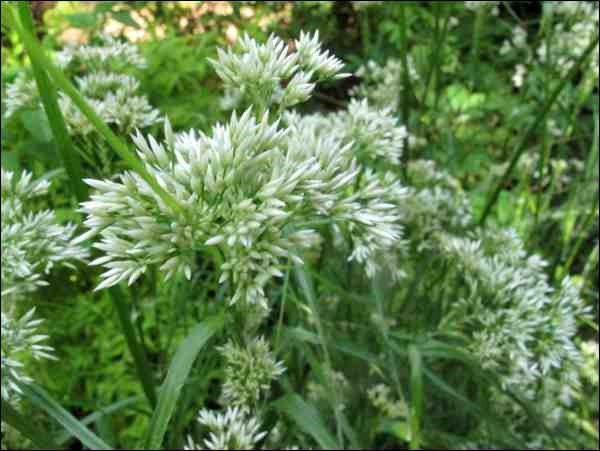A few of the plants we commonly refer to as grasses are in actual fact sedges or rushes. A true grass will have hollow, rounded stems with solid nodes. A sedge has three-sided or triangular stems that are solid or pithy, while rushes are most easily identified by their cylindrical leaves. A quick half-rhyme/half alliteration to help you remember the difference is "sedges have edges and rushes are round."
Sedges we commonly use as "ornamental grasses" are found in the genera Carex and Cyperus. The lone rush mentioned here is the snowy wood rush (Luzula nivea).
The Beatles (Carex caryophyllea), is named, of course, after the musical group of the 1960s, and sports a "hair-do" of narrow green foliage 20 cm/8 in. in height similar to the musicians. It spreads by short runners and gradually forms a colony. It does well in sun or shade on moist soil.
Blue Zinger carnation grass or blue sedge (Carex flacca; syn. C. glauca) [sometimes sold as C. nigra] is native to Europe. It has wide blue foliage to 20-25 cm/8-10 in. long and is more upright and clump-forming than the species. It is very hardy and easily propagated by division. It grows well in shade to sun on a wide range of soils.
Palm sedge (Carex muskingumensis) is fairly common in prairie gardens. Native to north-central North America, the green foliage is upright and arching to 60 cm (2 ft.) with brown flowers in summer. It spreads by rhizomes. An excellent bog plant, it grows well in sun to partial shade as long as moisture is adequate. There are two selections you might consider. Oehme, selected by landscape architect Wolfgang Oehme, begins green and has narrow yellow margins by mid-summer. Little Midge is a dwarf palm sedge one quarter of the size of the species (20-30 cm/8-12 in.)
Black flowering sedge (Carex nigra) is native to wet areas of Europe and eastern coast of North America. It is considered an extremely variable species and is 30- 80 cm (12- 30 in.) tall. The foliage is often a glacous blue and the female flowers are a distinctive black. It spreads by rhizomes and does well in full sun to light shade. Variegata is a selection with blue leaves with lime yellow margins; 30 cm/12 in. tall.
Umbrella sedge (Cyperus alternifolius) is a tender pond plant. If you want it to survive, bring it indoors for the winter. Clump-forming and spreading by rhizomes, it has leafless stems with enormous umbels on top, under ideal conditions reaching a height of 1m/3 ft. It closely resembles the even more tender papyrus sedge (Cyperus papyrus), widely available as King Tut and used in container arrangements. However, like its sedge relatives it requires relatively high soil moisture conditions, as it is a bog plant under natural conditions.
Snowy wood rush (Luzula nivea) is a hardy, clumping, loosely tufted rush with green foliage with white hairs along the leaf margin. About 20 cm/8 in. in height, it has a delicate appearance and off-white flowers in June. It does best in sun or partial shade with even moisture. Two selections to consider are the easy-to-grow Ruby Stiletto or Schneehaschen (little snow hare). The compact (30 cm/12 in.) Ruby Stilletto is a good filler with ruby red foliage in winter and early spring. Schneehaschen's main feature is its nearly white flower heads. The species can be propagated by seed while the two cultivars should be divided.
- This column is provided courtesy of the Saskatchewan Perennial Society (www.saskperennial.ca; [email protected]).




